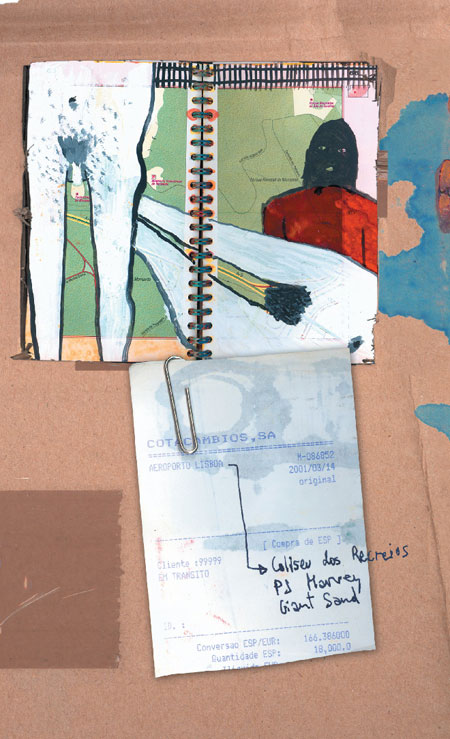lisboa revisited xabier gantzarain
Hasi ninteke arrazoitzen zergatik hasi nintzen Lisboako maparen gainean margotzen, baina zertarako? Artelan batek sekreturen bat gorde behar omen du ona izateko. Eta gainera, nola arrazoitu? Arrazoiak zerikusi gutxi du artearekin. Leku ezezagunetara heltzeko bide ezezagunak hartu behar direla esan omen zuen T.S. Eliottek. Eta gutariko bakoitzarengan artista bat bizi dela, Dubuffetek. Horregatik deitzen diot Artista Ezezaguna irudi hauek margotu zituenari: neure baitakoa izan arren, neure baitako alderdi ezezagunak margotu zituelako. Eskizofreniko xamarra dirudi baina hala izan zen.
Gainera, Lisboan jaio zen Fernando Pessoa. Eta Lisboan hil ziren, Fernando Pessoaz gain, bere heteronimoak. Inoren begietara, eskizofrenia literarioa. Eta bazekien eskizofreniaz eta lobotomiaz zerbait, kattagorriaren buruan agertzen den Egas Moniz-ek.
Alberto Caeiro, Pessoaren heteronimoetako bat, Joseba Sarrionandiaren poema batean ezagutu genuen. Poema hori Ruper Ordorikak musikatu zuen. Ni ez naiz Noruegako Errege diskoko bederatzigarren kantua da. Zortzigarrena, berriz, Bernardo Atxagaren testuan oinarritutako Berandu dabiltza. Eta harexen zati bat irakur daiteke intxaurraren gainean.
Arrazoi bat nahi duzuenontzat: Pott egin zidan bihotzak.
Pott Banda aipatu dut arestian. Kultura tortura dela abesten zuen Kortatuk, baina ez dut uste gaur egun berdina esango lukeenik Fermin Muguruzak. Niri behintzat lurralde ezezagunetara bidaiatzeko eta ateak irekitzeko balio izan dit. Aurkitu izan dut liburu, disko eta koadroetan, errealitateak eman ezin zidanetik. Halako mundu paralelo bat, esan guraz eta esanguraz betea. Elkar elikatzen baitira errealitatea eta fikzioa.
Baina ez dut astuna izan nahi. Ez naiz hain leloa: arterik gabe ere biziko ginateke. Xabi Ubedak fotomatoietan egindako argazkirik gabe ere biziko ginateke. Besterik da, ordea, nola biziko ginatekeen.
Eta Joseba Sarrionandiaren Nao es tu ezagutu gabe, Mikel Laboaren Nao es tu entzun gabe bizi, biziko ginateke, pentsuz hazitako izokinak bizi diren moduan. Bide-batez esanda, Nao es tu kantua entzunez begiratzen ditudanean, askoz ederragoak iruditzen zaizkit irudi hauek. Egin dezakezue froga zeuek. Hartu Mikel Laboaren Zuzenean diskoa. Jarri zazpigarren kantua. Laster hasiko da.
Kantuak iraun bitartean, erreparatu irudiei eta utzi hitz egin dezaten koloreek, marrek, zeinuek, kaleen izenek. Artista Ezezagunak margoen azpian ezkutatu nahi zituen sekretuak kausituko dituzue. Ez ziren erabat hondoratu denboraren lakuan, no lago do tempo.
Gainera, Lisboan jaio zen Fernando Pessoa. Eta Lisboan hil ziren, Fernando Pessoaz gain, bere heteronimoak. Inoren begietara, eskizofrenia literarioa. Eta bazekien eskizofreniaz eta lobotomiaz zerbait, kattagorriaren buruan agertzen den Egas Moniz-ek.
Alberto Caeiro, Pessoaren heteronimoetako bat, Joseba Sarrionandiaren poema batean ezagutu genuen. Poema hori Ruper Ordorikak musikatu zuen. Ni ez naiz Noruegako Errege diskoko bederatzigarren kantua da. Zortzigarrena, berriz, Bernardo Atxagaren testuan oinarritutako Berandu dabiltza. Eta harexen zati bat irakur daiteke intxaurraren gainean.
Arrazoi bat nahi duzuenontzat: Pott egin zidan bihotzak.
Pott Banda aipatu dut arestian. Kultura tortura dela abesten zuen Kortatuk, baina ez dut uste gaur egun berdina esango lukeenik Fermin Muguruzak. Niri behintzat lurralde ezezagunetara bidaiatzeko eta ateak irekitzeko balio izan dit. Aurkitu izan dut liburu, disko eta koadroetan, errealitateak eman ezin zidanetik. Halako mundu paralelo bat, esan guraz eta esanguraz betea. Elkar elikatzen baitira errealitatea eta fikzioa.
Baina ez dut astuna izan nahi. Ez naiz hain leloa: arterik gabe ere biziko ginateke. Xabi Ubedak fotomatoietan egindako argazkirik gabe ere biziko ginateke. Besterik da, ordea, nola biziko ginatekeen.
Eta Joseba Sarrionandiaren Nao es tu ezagutu gabe, Mikel Laboaren Nao es tu entzun gabe bizi, biziko ginateke, pentsuz hazitako izokinak bizi diren moduan. Bide-batez esanda, Nao es tu kantua entzunez begiratzen ditudanean, askoz ederragoak iruditzen zaizkit irudi hauek. Egin dezakezue froga zeuek. Hartu Mikel Laboaren Zuzenean diskoa. Jarri zazpigarren kantua. Laster hasiko da.
Kantuak iraun bitartean, erreparatu irudiei eta utzi hitz egin dezaten koloreek, marrek, zeinuek, kaleen izenek. Artista Ezezagunak margoen azpian ezkutatu nahi zituen sekretuak kausituko dituzue. Ez ziren erabat hondoratu denboraren lakuan, no lago do tempo.




